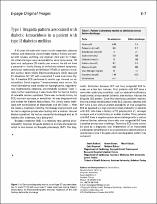Type I brugada pattern associated with diabetic ketoacidosis in a patient with type II diabetes mellitus
Citation
Kalkan, S., Güner, A., Kalçık, M., Geçmen, Ç., Özkan, M. (2019). Type I brugada pattern associated with diabetic ketoacidosis in a patient with type II diabetes mellitus. Anatolian Journal of Cardiology, 21(1), E1.Abstract
A 42-year old male with known insulin-dependent diabetes mellitus and otherwise unremarkable medical history presented with nausea, vomiting, and atypical chest pain for 2 days. His initial vital signs were remarkable for sinus tachycardia (101 bpm) and tachypnea (20 breaths per minute). He did not have a personal or family history of arrhythmia-related symptoms, ventricular tachycardia or fibrillation (VT/VF), or premature sudden cardiac death (SCD). Electrocardiography (ECG) revealed ST elevations (V1–V2) with associated T wave inversions (Fig. 1a). A baseline ECG performed 6 months ago showed no abnormalities. Serial troponin T measurements were normal. His initial laboratories were notable for hyperglycemia, hyponatremia, hyperkalemia, ketonuria, and metabolic acidosis (Table 1). Upon further questioning, it was found that he had no history of referable cardiac symptoms. There was no family history for SCD, recurrent syncope, or arrhythmia. He was diagnosed with and treated for diabetic ketoacidosis. His clinical status stabilized with normalization of electrolytes and pH (Table 1). After the medical treatment, ECG (Fig. 1b) showed improvement, and he had a negative provocative testing with a sodium channel blocker (ajmaline). He had an uneventful discharged and, at 10 months after treatment, he is doing well.


















